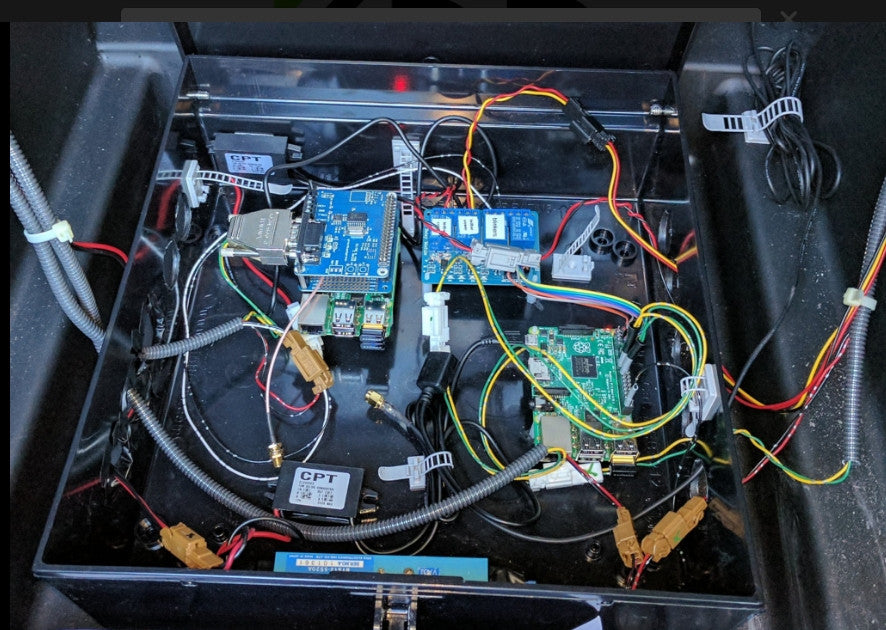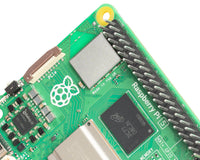
An open source car, a new Compute Module and a Pi Zero mobile phone in today's Raspberry Pi Roundup
French Open Source car uses Raspberry Pi

French car manufacturer Renault are to launch an open source car platform called POM (based on Twizy), it was announced at CES last week. What seems to have slipped under the radar is that there are two Raspberry Pis on board! Businessman and author Chris Anderson was lucky enough to get a glimpse of the internals of the car and took the photo above, tweeting it later. They appear to be Pi 2s (because they’ve got wifi dongles, I’m making that leap in logic) and are using Sukkin Pang’s CAN-bus HATs, which are designed and manufactured in the UK, to talk to, I assume, the engine and onboard diagnostics. Read more about POM here.
Compute Module 3

Raspberry Pi has announced the launch of two new versions of the Raspberry Pi Compute Module. The two versions, known as CM3 and CM3L (lite) feature the Pi 3’s BCM2837 CPU and 1GB of RAM, an upgrade from the 512MB of the CM1. Also released is a new version of the development board which breaks out all the interfaces, pins and slots that are available to the CPU. The lite version “still has the same BCM2837 and 1Gbyte of RAM but brings the SD card interface to the module pins so a user can wire this up to an eMMC or SD card of their choice.”
They’ve kept the form factor roughly the same, although as James Adams, Hardware Lead at Raspberry Pi, comments:
The CM3 is largely backwards compatible with CM1 designs which have followed our design guidelines. The caveats are that the module is 1mm taller than the original module and the processor core supply (VBAT) can draw significantly more current and consequently the processor itself will run much hotter under heavy CPU load – i.e. designers need to consider thermals based on expected use cases.
The new Compute Modules and development board are available from element14 and RS Components.
Mobile Pi Phone
There have been several Raspberry Pi-powered mobile phone builds over the past few years (Tyler Spadgenske and David Hunt) but none have used the Pi Zero… until now. (Cue dramatic music).
Arsenijs from Latvia has created the ZeroPhone, and he reckons it has only cost around $50 to build! It can be used for making calls, sending SMS messages and has various text-based mini-apps pre-loaded. It runs Raspbian and pyLCI for the UI elements. The bill-of-materials is as follows:
- Pi Zero – easy to get despite people on Internet still telling otherwise (I got 5 by now). Let’s say it’s 5$ and 5$ for shipping.
- SIM800 modules – available in large quantities from eBay, 5$.
- ESP8266-12E used for WiFi (as per RPi-WiFi project) – 2$ from eBay
- Two-layer PCBs (two 4x10cm boards, one 4x6cm board) – can be ordered from your favourite fab or whatever people on Internet give good reviews about.
- ATMega328P – can be desoldered from an Arduino Pro Mini that’s typically 2$ on eBay, and it comes with a bootloader already! If you don’t have a heat gun, you can just buy a bare chip and burn a bootloader to it using a programmer.
- LCD screen – 5$ on eBay. Besides, a project like this can use other screen breakouts with similar characteristics (such as the ubiquitous Nokia displays) – it’s just a matter of writing a driver, which is easier than it sounds, and the front board accepts different display pinouts.
- Battery – you can use cell phone batteries, pouch and 18650 cells.
- TP4056 battery charger – modules are available from eBay, 1$.
- Buttons for keypad – 2$ from eBay (there are 3 types used, but you can omit one).
- 2.54 headers (both dual-row and single-row) – dirt cheap. Won’t be more than 0.50$ to have enough to assemble the phone.
It’s currently at working prototype stage and is, basically, a Pi Zero sandwiched between circuit boards. You can read more over on Hackaday.io.






